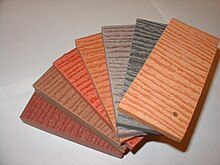Related Questions: What is "MTWood"?
Related Products: Please click here
Wood-plastic composites (WPCs) are composite materials made of wood fiber/flour and plastic(s). In addition to wood fiber and plastic, WPCs can also contain other ligno-cellulosic and/or inorganic filler materials. WPCs can also be referred to as natural fiber plastic composites or natural fiber reinforced plastics.
There are also applications in the market, which utilize only virgin raw materials. Its most widespread use is in outdoor deck floors, but it is also used for railings, fences, landscaping timbers, cladding and siding, park benches, molding and trim, window and door frames, and indoor furniture. Manufacturers claim that wood-plastic composite is more environmentally friendly and requires less maintenance than the alternatives of solid wood treated with preservatives or solid wood of rot-resistant species. Resistant to cracking and splitting, these materials can be termites or rot quickly cause of the wet and warm weather.
Wood-plastic composite is still a very new material relative to the long history of natural lumber as a building material but can be substituted in most non-structural instances.
Wood-plastic composite lumber is composed of wood from recovered saw dust (and other cellulose-based fiber fillers such as pulp fibers, peanut hulls, bamboo, straw, digestate, etc.) and virgin or waste plastics including high-density polyethylene, PVC, PP, ABS, PS .... The powder or fibers are mixed to a dough-like consistency and then extruded or moulded to the desired shape. Additives such as colorants, coupling agents, stabilizers, blowing agents, reinforcing agents, foaming agents, lubricants help tailor the end product to the target area of application.

A major advantage over wood is the ability of the material to be molded to meet almost any desired spatial conditions. It can also be bent and fixed to form strong arching curves. Wood-plastic composites behave like wood and can be shaped using conventional woodworking tools. At the same time, they are moisture-resistant and resistant to rot, although they are not as rigid as wood and may slightly deform in extremely hot weather. A major selling point of these materials is their lack of need for paint as they are manufactured in a variety of colors, but are widely available in grays and earth tones.